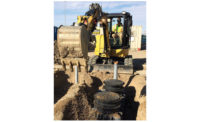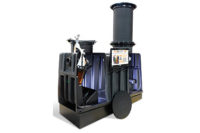Grease interceptors recently have been receiving more attention as regulators in many municipalities impose more stringent regulations to reduce the amount of fats, oils, grease and food solids found in city wastewater collection systems.
Restaurants, industrial food facilities and other commercial food-service establishments are significant sources of FOG because of the amounts produced from cooking, food preparation and cleanup work. More regulators are beginning to echo the message: “FOG isn’t just limited to what you cook, it has a lot to do with what you wash (i.e. washing pots, pans and dirty dishes).” FOG sticks to the sides of kitchen plumbing pipes and eventually finds its way into sewers and hardens inside pipes.
These events lead to blockages that clog sewer pipes and can cause raw sewage to overflow onto streets, and into homes and businesses — costing our municipalities a lot of money due to problematic disruptions (i.e., road closures, costly emergency services and business interruptions).
When grease interceptors malfunction there are virtually no early warning signs.
Operations maintenance and system design
While grease pumpers claim “skimming grease” is a cost-effective alternative, the impacts of these practices can be detrimental. Settled food solids left in the bottom of concrete and metal grease interceptors for prolonged periods of time can cause highly acidic conditions (i.e., low pH and aggressive free-fatty acids).
Over time these acidic conditions can cause significant deterioration in metal and concrete tanks that can eventually lead to premature replacement of grease interceptors. In concrete tanks (that do not have protective additives in the aggregate mix), leaching can occur. Cement separates from the concrete walls, passes through to sewers and calcifies down the line to create rock-hard blockages. Additionally, steel reinforcement in concrete tanks (rebar) can become exposed to accelerated corrosion.
Grease interceptors are manufactured out of several different materials giving owners, designers and municipalities options to consider. However, with more stringent regulations becoming more prevalent, facility managers and owners are turning to fiberglass grease interceptors as the preferred choice because of their long-term benefits and proven performance in highly corrosive environments.
To ensure proper disposal of FOG and to prevent sewage backups, municipalities require commercial and industrial FOG-generating food-service establishments to properly install, operate and maintain correctly sized and designed grease interceptors. Some jurisdictions also are beginning to pay close attention to the need for filtering FOG-laden food solids before they enter kitchen pipes and end up in the bottom of grease interceptors.
This is important because a significant volume of grease accumulated inside grease interceptors is released from the decaying food (settled solids) and floats to the top of the tank adding to the grease layer. Food solids separators that filter out solids before they cause problems are beneficial to owners and operators for three reasons:
• Clogs in pipes are reduced; minimizing emergency service costs and downtime;
• Preventing decaying food solids from settling inside grease interceptors reduces the risk of accelerated deterioration of metal and concrete tanks, and can lead to favorable conditions regarding odor control.
• Removing food solids from the waste stream increases the grease interceptor’s ability to capture and retain fats, oils and grease; their main purpose.
Options galore
There typically are two types of grease interceptors used in commercial and institutional kitchen applications.
• Hydromechanical grease interceptors, more commonly known as grease traps are usually found indoors in close proximity to the discharge point. These grease traps typically are constructed of steel or polypropylene plastic and are compact in size.
• Gravity grease interceptors are engineered and prefabricated units constructed of materials such as fiberglass, steel, polyethylene and precast concrete. The sizes of these grease interceptors typically are large and located outside the given facility.
Facility managers and property owners sometimes make buying decisions based on lifecycle costs. The total cost of ownership typically considers the initial purchase cost, ongoing maintenance costs and the replacement costs.
Unfortunately, many of these decisions are made based on installing the smallest unit allowable combined with the lowest possible price. Spending the bare minimum to get by can significantly impact the facility’s ability to control FOG discharges and can lead to much greater lifecycle operating costs over the medium to long term.
There are five key factors that facility managers and owners should consider when selecting the appropriate grease interceptor design for a project.
1. Grease interceptor material choices: When comparing tanks, concrete always seems to be the default choice when property owners and food-service operators do not specifically request a more appropriate material. This is, in part, because concrete has been the material of choice in the past.
Fiberglass tanks have become the industry standard for numerous underground tank storage applications such as gasoline stations and jet-fuel storage at airports. The choice for grease interceptors should be no different since internal tank corrosion is a major consideration in both applications. The performance benefits and longevity of fiberglass storage tanks should be considered a superior option for effective, long-term FOG control by forward-thinking facility managers and property owners.
Fiberglass offers a full range of performance benefits that facility managers and owners should expect when specifying effective, performance-driven grease interceptor equipment needed to control FOG.
• Strong structural design for water loading conditions makes fiberglass ideal for installations in parking lots and high-traffic areas.
• Installation steps and costs are minimized by the lightweight nature of fiberglass. This is an important consideration when tank installation sites are difficult to access. When comparing fiberglass to concrete grease interceptors there are a few more factors to consider.
• Concrete grease interceptors are susceptible to corrosion, leading to performance failures, odor issues (embedded bacteria) and leaks. Concrete grease interceptors can be designed with an internal lining in an attempt to provide an added level of protection, but due to free-fatty acids and acidic conditions often present inside grease interceptors, internal coatings may only serve to delay the deterioration of these types of tanks.
• Concrete tanks also are extremely heavy, adding to installation difficulty and cost. Many concrete tanks are not designed for water loads so the placement of a concrete grease interceptor can be limited to non-traffic locations. Metal tanks, such as steel, also present certain disadvantages when used to fabricate grease interceptors.
• By nature of the material, metal tanks are prone to corrosion. Both internal and external coatings are recommended. As with all tanks, regular maintenance/inspections during the life of the tank are required when attempting to manage them through to their designed useful life.
• Fiberglass can provide the structural integrity that metal tanks offer but without the need to use coatings and cathodic protection to survive the corrosive environments found in grease interceptors.
2. Size and flow rates really do matter: Determining the correct size of a grease interceptor is an important consideration.
• If you have a tank that is too small or too large for your needs, maintenance and cleaning can become more difficult and increase the cost to operate the facility where the grease interceptor is installed.
• FOG and food solids stored for prolonged periods smell bad. When maintenance and cleaning becomes difficult due to improper sizing of the grease interceptor, the odor can linger into parking-lot areas causing the initial customer experience to be an unpleasant public nuisance.
• Fiberglass storage tanks are designed, constructed and sized to conform with recognized plumbing codes requiring one- to 30-minute retention times.
3. Proper maintenance of grease interceptors: Fiberglass grease interceptors require minimal maintenance when it comes to the cleaning of the interior tank walls. Alternatively, concrete grease interceptors without a liner have porous surfaces where bacteria can reside and start to corrode structural integrity. In comparison to concrete, fiberglass grease interceptors have a smooth nonporous surface, which reduces the amount of residue and bacteria that can build up and enter the wastewater collection system.
4. Monitoring system for ease of mind: Grease in tanks that overflows and spills into the environment requires close attention. Regulators can impose monetary fines and/or facility shutdowns if facility managers and owners fail to comply with the municipality’s regulations.
In an effort to measure and verify grease interceptor operational efficiencies and drive costs down, many facility managers and owners are choosing to install electronic interceptor monitoring devices to measure the accumulation of FOG as well as the level of sludge (food solids) at the bottom of their grease interceptors. A monitoring system allows facility managers to monitor tank functionality from the control unit without having to physically open the tank lids.
Compliance with changing regulations
Even the U.S. Environmental Protection Agency realizes FOG control methods used by food-service businesses and regulators are outdated.
This has made compliance efforts costly and difficult for all stakeholders. Advanced interceptor monitoring devices, and electronic reporting help to make compliance efforts more clear, consistent and predictable. They also drive costs down by protecting investments in infrastructure.
FOG, food solids and free-fatty acids combine in grease interceptors to create the right conditions to form hydrogen sulfide gas-H2S (it’s the noxious rotten egg smell that comes from sewers and grease interceptors). Once combined with oxygen, H2S aids in the creation of sulfuric acid which can destroy concrete. This biological activity equates to a bacteria known as Thiobacillus Concretivorous, which is Latin for “eats concrete.” An experienced microbiologist likely is to be the best source of information when considering the effects that FOG has on concrete grease interceptors.
Municipalities have increased the enforcement of regulations due to the amount of sewer system discharge violations. These violations can result in a water/sewer bill surcharge of at least 50% or more in many jurisdictions.
These deteriorating effects on grease interceptors have prompted major metropolitan areas such as Miami-Dade County, Fla., to develop regulations to help reverse this destructive trend.
Preventive maintenance is the key. Leveraging technology that monitors and data-logs FOG accumulation allows a business to know exactly when to clean their grease interceptors.
This can result in significant cost savings. When combined with an at-source food solids separator, interceptor monitoring devices can help businesses avoid over- or under-pumping their grease interceptors. Environmental regulators can more easily focus their enforcement and compliance efforts on those businesses that are late to adopt preventive/predictive FOG technologies.
Businesses that fail to become transparent in the effort to keep FOG out of sewers and public waterways will likely find distinct disadvantages. The unpredictable costs of FOG-related “urgent care emergencies” will put undue pressure on their profit-and-loss statements as operations and maintenance costs increase. Prevention is the best pathway for effective FOG control.
The type of grease interceptor utilized in FOG-generating food establishments has become an important element when confronting corrosion issues. Interceptor Monitoring Devices installed with grease interceptors can put your mind at ease with the ability to remotely monitor the function of an interceptor and immediately notify the owner’s facility managers when there is a potential issue.
The type of material used to manufacture a grease interceptor has become important today. When combined with effective FOG control technologies, fiberglass grease interceptors continue to emerge as the preferred choice of system designers, owners and regulators across North America because of their resistance to corrosion, solid-built quality and long-term 30-year warranty.






